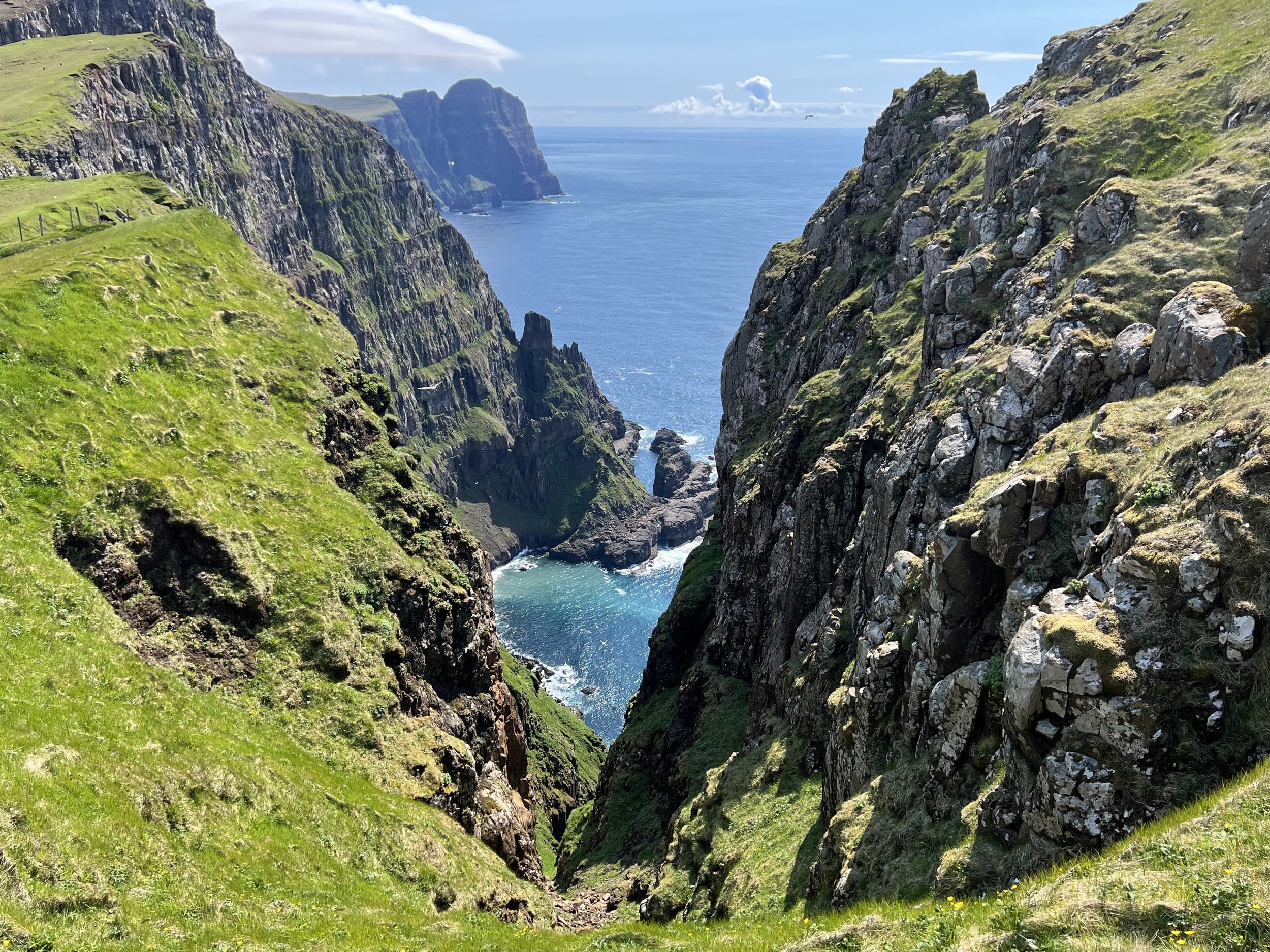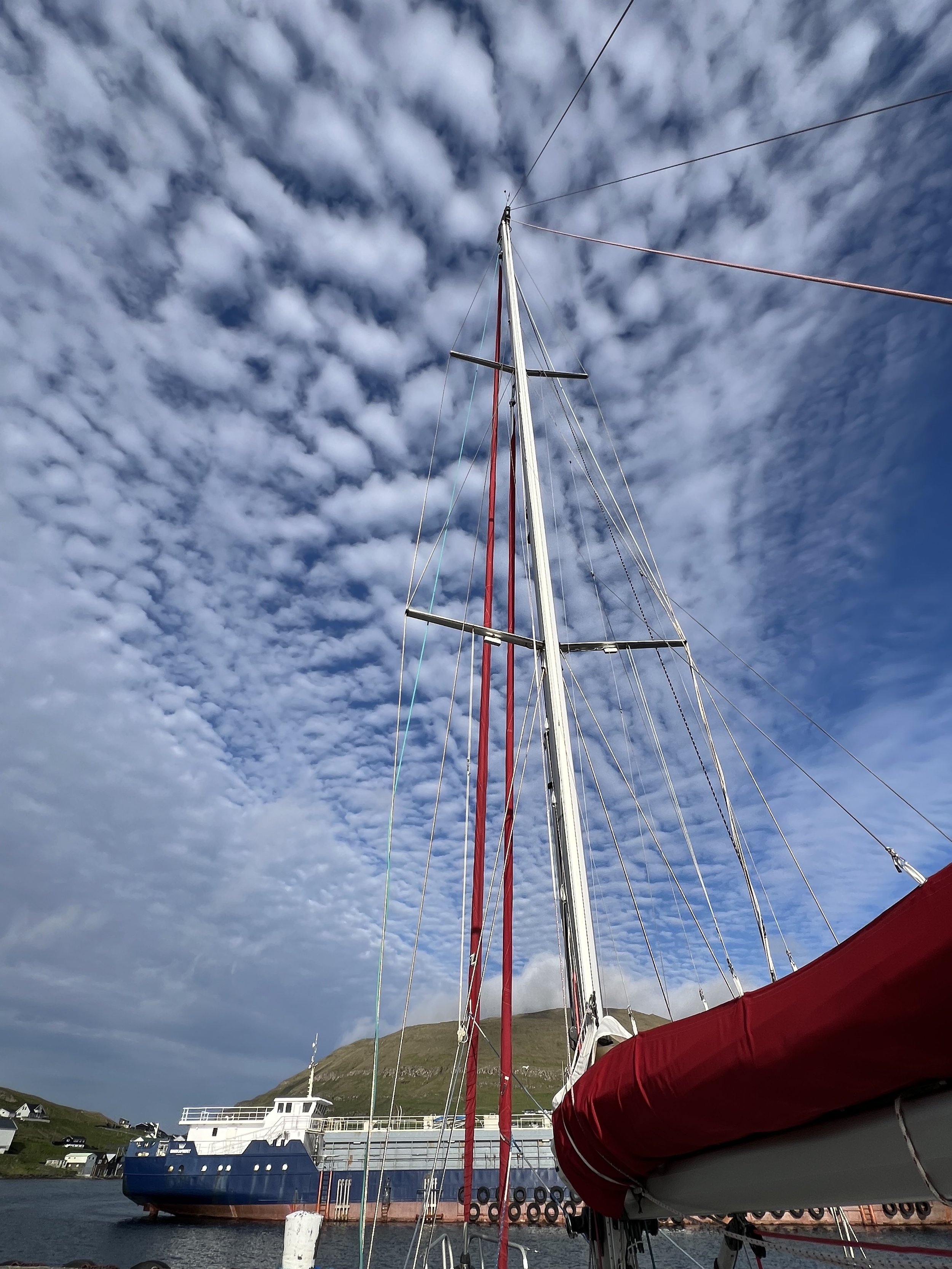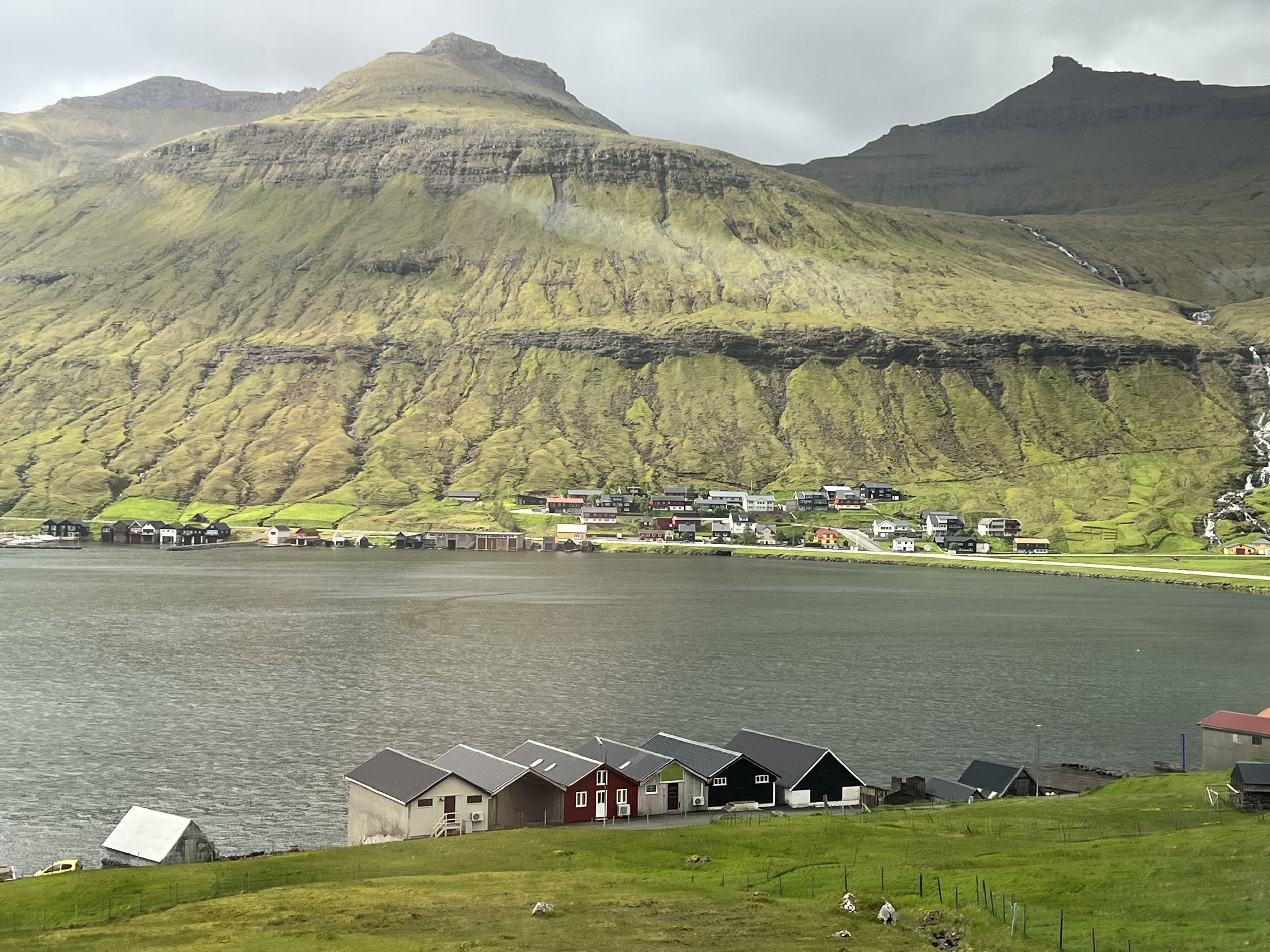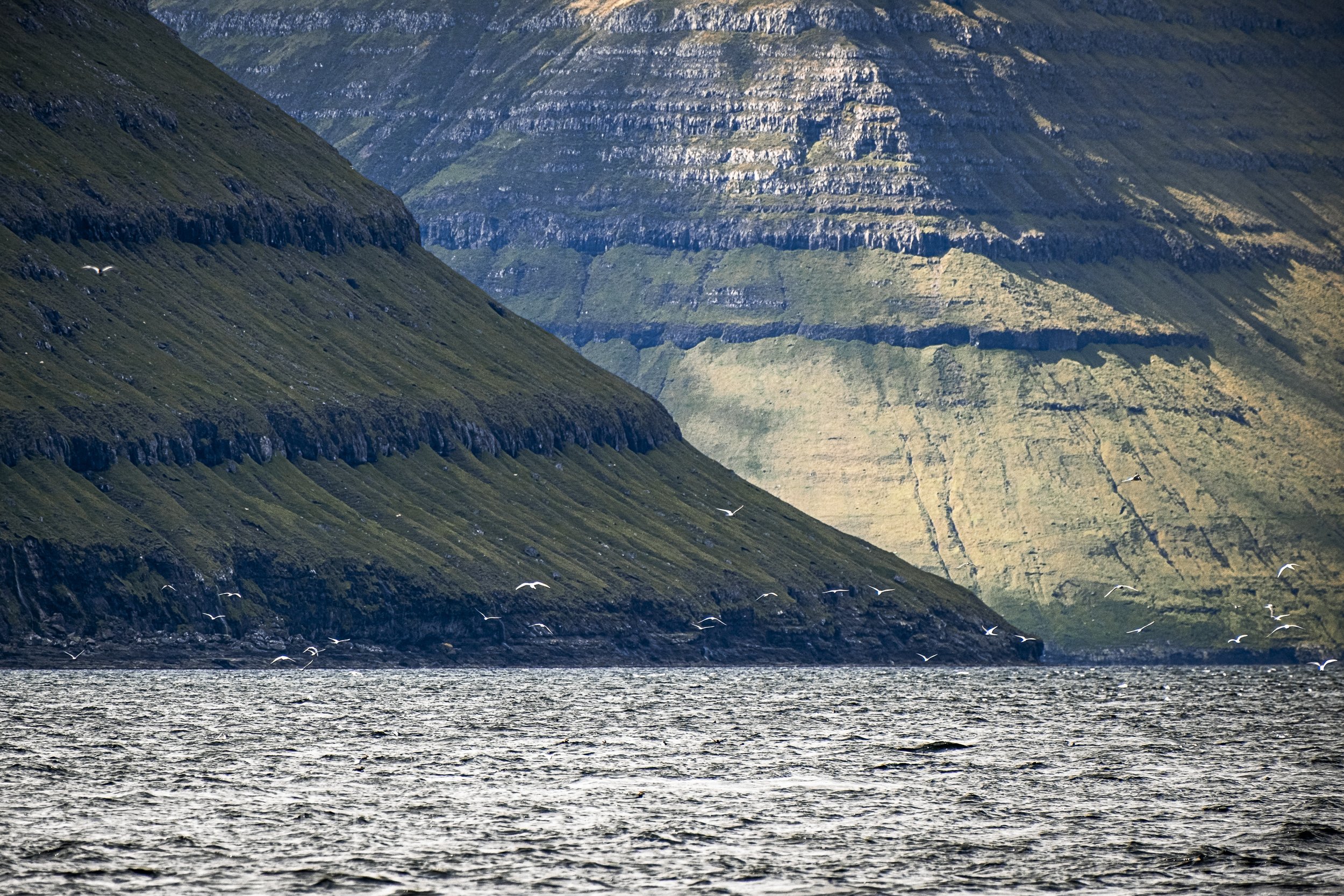Cliffs and Clouds, the Faroe Islands.
West coast of Suðuroy.
The sail north from Scotland was squally and sporty at times. The winds a little higher than anticipated and the left over waves from the previous gale made for a rough ride. Then the winds left us and we motored the last part into the southernmost island, Suðuroy, and the small town of Vàgur.
Sunrise over the North Atlantic waters.
After a very efficient meeting with the immigration official who drove out to check us in on a Thursday evening, we lowered the Q flag and caught up on our sleep. The next morning was bright and sunny, we knew this was going to be a rare event so we went out to explore.
Vàgur wraps around the tip of the fjord, the colorful metal roofs and painted houses were bright against the greenest of green grass.
As we walked up the hill, we met the predominant inhabitant of the islands, the Faroese sheep. They were quite interesting with their chimeric coat colors and dreadlock style wool. Much more delicate, we were told, than the Scottish sheep wool
Meeting one of the locals.
The hike took us to Eggjarnar, the site of the now abandoned Loran-A station. Built during World War II, four high radio masts provided long range radio signals which were used to guide aircraft and ships across the Atlantic. It was abandoned in the 1970’s as satellite GPS took over and an earthquake made the site unsafe.
The view along the cliffs was spectacular.
The hike continued on up the hill for more fantastic views of the sheer cliffs and many seabird colonies.
The Faroese smack,, Johanna was tied up along side us. Made in Rye, on the south coast of England in 1884, Johanna sailed large quantities of fish from Iceland to England up to and throughout the second world war. Her achievements were even mentioned in a speech by Winston Churchill after the war. In 1980 she was sold for less than $1 and has been lovingly restored and is now chartered to take visitors out.
Mackerel skies, an indication of changing weather.
We left the following day, having a lovely sail in perfect conditions north to Tórshavn, the capital of the Faroe Islands. There were two successive gales forecast, and we were not the only ones seeking shelter in the marina there. A polish flagged boat slowly passed us, we told ourselves it was not a race.
We passed the smallest island in the Faroes, Lítla Dímun. Its sheer cliffs and steep grass covered upper levels made it totally inhospitable, and it was indeed uninhabited, at least by humans. Apparently it is used for grazing sheep still. They are deposited in spring and gathered each fall, rowing skiffs are taken to the island and a human chain fans out across the hills, herding the sheep into pens. They are then put in nets and lowered, 5 at a time, into the waiting skiffs and taken back to the “mainland”. There are ropes secured along the cliffs for “easy” access.
Lítla Dímun.
Tórshavn, founded in the 9th century, was the site of the Viking parliament, for the Faroes. The site called Tinganes, has old government buildings, some still in use today, which are clustered onto the rocky peninsula. The buildings are traditonal Faroese style, with sod roofs, although these government buildings are red, not the traditional black.
The small neighborhood just north of Tinganes was a maze of the traditional black houses with white windows and sod roofs. In many you could see the traditional silver birch bark that sealed the roof from dripping water. Surely something better than that is used these days. Harking back to my childhood, we saw a pram with baby, just left out on the street for their afternoon nap in the fresh air. How European.
The town wrapped around several marinas catering for boats from cruise ships, container ships and naval vessels down to us cruising yachts and small fishing boats. Our not so near neighbor was selling cod that he caught, and 4 days later it was still hanging in the rigging. Smelt like you can imagine.
As the gales passed we ticked off a few boat projects. The most important being to identify the source of an oil leak, and fix it. Also to replace the clear plastic eisenglas in a couple of the cockpit enclosure panels. One had cracked, and the other was similarly worn.
We also met Helen and Mike from SV Pangey, experienced sailors who have not only visited Faroes, Iceland and Greenland on many occasions, but also wrote the Cruising Association guide to these shores. It was wonderful to spend a few evenings, sharing meals and pouring over the charts and slides to help get us up to speed.
We wanted to explore more of the islands, and Tórshavn was a good base to do that from. The islands from here heading north are all connected by either tunnels or a bridge. We could simply hop on a bus, and cover a lot of ground that we simply did not have the time to explore by boat. The 400 bus from Tórshavn to Klaksvik was perfect. Multiple tunnels and the one bridge in the Faroes.
In Klaksvik we found a trail that led up the mountain to a radio station. It was a steep trail then boggy hike. But the views down from the summit were spectacular.
Looking north down Kalsoyarfjørður.
A couple of days later the weather was calm and we left the marina to head over to Hestur, a small nearby island with dramatic cliffs. The tidal races between these islands are severe. There is even an App to help you time your passages. The strong tides can kick up quite a chop if the wind is contrary. We had the tides in our favor and the wind was light, so it was an uneventful trip.
Hestur with Kóltur in the middle distance.
Southern cliffs of Hestur.
Helacious found a snug berth in the harbor and we went for a walk. It was a slow day in “town” and it seems the local residents pass the time with football target practice. We did not hang around, but started the climb. The view from the top were impressive with Fulmar gulls wheeling around.
As we laboriously clambered down, we were passed by this young man, Johannes, who literally skipped past us. He had been fishing in the lakes on the top of the island. When we got back to the harbor he was fishing again while waiting for the ferry to take him back to Tórshavn. We asked him about his catch, then, as it was raining, invited him onboard for a cup of coffee to pass the time. We had such a good time chatting, he nearly missed the ferry.
The turf roofs were quite common, all through the Faroe Islands, but not all as cute as this one. The black walls look like they were treated maybe with hot tar, not just painted black.
Nólsoy.
The next day we took the morning tide out and crossed over to Nólsoy, across the sound from Tórshavn, but a world away.
Nólsoy is known for its bird colonies, specifically the European Storm-petrel. Half the world’s population nest here. The Storm petrels were very shy, however we did enjoy spotting these Arctic terns, puffins, Eider ducks and the Great Skua.
We went on a couple of walks on Nólsoy, the one down the length of the island started off fine, but about half way just became a boggy mess, and I unfortunately became a victim.
Nólsoy looking north.
Our last stop in the Faroe Islands was Fuglafjørður, recommended to us as a good place to wait for weather for our next passage on to Iceland. As with all the sailing around these remote islands, the scenery was dramatic.
We spent a few days in Fuglafjørður, adding a little to our provisions. The main reason for stopping here was the ease of refueling. With all the motoring around Scotland in those lovely sunny and windless days, we needed to top up. Here the pontoon was the fuel dock. The problem was, how to pay. As boat fuel is taxed differently to auto fuel, it was necessary to have a fuel card to purchase diesel at the reduced tax rate. We did not have this. However we managed to contact the fuel supply company and they sent a technician over to provide the card and we could then reimburse him in cash. Of course with the limits on daily ATM withdrawals, this was also a delicate balance on how much to take out, and not be stuck with excess Faroese Krone. We were successful (of course) and just have a little left over.
The weather forecast had strong and steady wind in the right direction, from the SE. However the waves predicted were quite high and steep. We were a little conflicted. Should we or shouldn’t we make the escape across to Iceland. The journey was only a couple of days and the wind and waves would be behind us, thereby reducing their ferocity. We felt maybe we had been too timid in past passages, often resulting in simply too little wind and resorting to wallowing around in lumpy seas which is absolutely the worst combination. We decided to go for it and at 5am the following morning we untied the lines and headed out, using the currents to speed us on our way.
Iceland, this way.
Farewell Faroe Islands.
Follow our progress on the tracking page.
https://forecast.predictwind.com/tracking/display/SVHelacious/







































































































